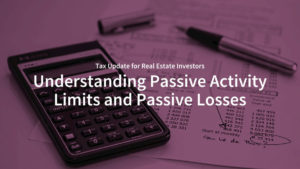
Image from https://www.stessa.com/
Many years ago, the passive-loss rules caused taxpayers many problems, especially those who owned rental property. The passive losses you incur become non-tax-deductible unless you meet strict requirements.
Today, these issues still exist, but there are ways around them.
Here’s what you must know.
How Taxes are Categorized
Lawmakers forced taxpayers to put their taxable activities into three categories:
- Income from stocks and bonds
- Income from active business activity
- Income from passive activities, such as rentals (the trap)
If you’re stuck in the passive-loss trap, here are three ways to get out of it.
Low-Income Write-Offs
If you make less than $100,000 per year, you can deduct up to $25,000 in losses from a rental property.
This ‘freebie’ decreases if you make between $100,000 – $150,000 by 50% and is eliminated if you earn over $150,000.
Change Operations
To be eligible for a passive income tax loss from rental properties, you must have multiple sources of passive income or qualify in the IRS’s eyes as a real estate professional, materially participating in the rental property.
If you don’t qualify as either, and have unclaimed passive losses, here are some ways out:
- Transform a rental property into a non-passive income-generating property
- Become a real estate professional in the eyes of the IRS
- Create more passive income opportunities
Sell the Property
Your final escape is the most drastic but will release all those saved up deductions. If you dispose of the property by selling it, you can write off the losses, decreasing your capital gains and lowering your tax liability.
I know it seems confusing and even unfair to have passive losses ‘trapped,’ but there are ways around it.
I’d love to help you take advantage of these escapes, giving you the tax breaks you deserve. Contact me today.
